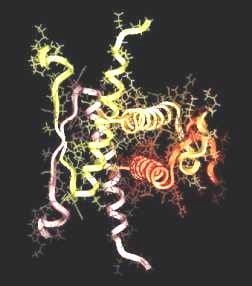Researchers from ICIQ and IRB design a molecule that stabilizes the main natural supressor of tumours
An interdisciplinary team of researchers, leaded by Prof. Javier de Mendoza (ICIQ, Tarragona) and Prof. Ernest Giralt (Institute for Research in Biomedicine – IRB Barcelona), have discovered a substance able to maintain protein p53 stable and active even when it presents certain mutations that promote the appearance of cancer.Giralt, head of the Chemistry and Molecular Pharmacology programme and Full Professor at the University of Barcelona, explains that tentatively, this could be the starting point to develop a new approach for anti-tumour treatments. The study has been published today in the journal Proceedings of the National Academy of Sciences of the U.S.A. (PNAS) in the early edition.
Protein p53 is considered the most important tumour suppressor and is at the centre of the machinery that regulates cell cycle arrest and the death of cells with damaged DNA. In its active form, p53 protein is a tetramer, that is, it is formed by four identical copies of proteins bound together, which has four domains with differentiated functions: activation of transcription, DNA binding, tetramerization and regulation. The tetramerization domain is responsible for stabilizing the tetrameric structure.

Tridimensional structure of tetramerization domain of p53 protein
More than 50% of cancer patients have mutations in the p53 gene. Although most of these mutations are located in the DNA binding domain, several are found in the tetramerization domain, thereby causing destabilization of the entire protein with the consequent loss of activity. Therefore, the design of compounds with the capacity to stabilize the tetramerization domain of p53 represents a new and attractive strategy for the development of anti-tumour drugs.
The article describes the design, synthesis and study of a compound with the capacity to interact with the p53 tetramerization domain. Javier de Mendoza, Group Leader at ICIQ and Full Professor at the Universidad Autónoma de Madrid, explains that it is a conical shaped molecule with four positive charges prepared to recognize and stabilize four negative charges of the protein. To obtain results in the design and study of new molecules, it is necessary to have an in-depth knowledge of the language that proteins use to communicate with each other, to recognise each other and to bind to exert their function. From this perspective, more associated with basic science, de Mendoza emphasizes that the study demonstrates the high level of maturity that has been reached in the field of molecular recognition.
Susana Gordo, co-author of the work and researcher from Giralt’s team, explains that this work also opens up a new way for the design of drugs based on the use of small molecules that act as moulds or tethers to preserve the active form of proteins. Among the possible applications of synthetic binding compounds, the researchers point out the stabilization of native forms of proteins or the recovery and rescue of mutated proteins.
The design and analysis of the compound has also involved the collaboration of the biochemist Vera Martos, from Javier de Mendoza’s team, the one that has synthesized the molecule that interacts with the protein, and the researcher Margarita Menéndez at the Consejo Superior de Investigaciones Científicas. The computational chemistry part of the study was directed by Prof. Carles Bo at ICIQ, with the help of Eva Santos, from the same institute.
Related news

Let's create a brighter future
Join our team to work with renowned researchers, tackle groundbreaking
projects and contribute to meaningful scientific advancements






 27-05-2022
27-05-2022 
















